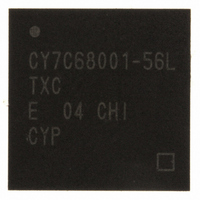CY7C68001-56LTXC Cypress Semiconductor Corp, CY7C68001-56LTXC Datasheet - Page 16

CY7C68001-56LTXC
Manufacturer Part Number
CY7C68001-56LTXC
Description
IC USB EZ-USB SX2 HS 56VQFN
Manufacturer
Cypress Semiconductor Corp
Series
CY7Cr
Type
USBr
Specifications of CY7C68001-56LTXC
Protocol
USB 2.0
Voltage - Supply
3 V ~ 3.6 V
Mounting Type
Surface Mount
Package / Case
56-VQFN Exposed Pad, 56-HVQFN, 56-SQFN, 56-DHVQFN
Lead Free Status / RoHS Status
Lead free / RoHS Compliant
Number Of Drivers/receivers
-
Lead Free Status / Rohs Status
Lead free / RoHS Compliant
Other names
428-2932
Available stocks
Company
Part Number
Manufacturer
Quantity
Price
Part Number:
CY7C68001-56LTXC
Manufacturer:
CYPRESS/赛普拉斯
Quantity:
20 000
After the entire descriptor has been transferred, the SX2 will float the pull-up resistor connected to D+, and parse through the
descriptor to locate the individual descriptors. After the SX2 has parsed the entire descriptor, the SX2 will connect the pull-up
resistor and enumerate automatically. When enumeration is complete, the SX2 will notify the external master with an ENUMOK
interrupt.
The format and order of the descriptor should be as follows (see Section 12.0 for an example):
4.2
The external master may simply load a VID, PID, and DID and use the default descriptor built into the SX2. To use the default
descriptor, the descriptor length described above must equal 6. After the external master has written the length, the VID, PID,
and DID must be written LSB, then MSB. For example, if the VID, PID, and DID are 0x04B4, 0x1002, and 0x0001 respectively,
then the external master does the following:
The default descriptor is listed in Section 12.0. The default descriptor can be used as a starting point for a custom descriptor.
5.0
The SX2 will automatically respond to USB chapter 9 requests without any external master intervention. If the SX2 receives a
request to which it cannot respond automatically, the SX2 will notify the external master. The external master then has the choice
of responding to the request or stalling.
After the SX2 receives a set-up packet to which it cannot respond automatically, the SX2 will assert a SETUP interrupt. After the
external master reads the Interrupt Status Byte to determine that the interrupt source was the SETUP interrupt, it can initiate a
read request to the SETUP register, 0x32. When the SX2 sees a read request for the SETUP register, it will present the first byte
of set-up data to the external master. Each additional read request will present the next byte of set-up data, until all eight bytes
have been read.
The external master can stall this request at this or any other time. To stall a request, the external master initiates a write request
for the SETUP register, 0x32, and writes any non-zero value to the register.
If this set-up request has a data phase, the SX2 will then interrupt the external master with an EP0BUF interrupt when the buffer
becomes available. The SX2 determines the direction of the set-up request and interrupts when either:
For an IN set-up transaction, the external master can write up to 64 bytes at a time for the data phase. The steps to write a packet
are as follows:
To send more than 64 bytes, the process is repeated. The SX2 internally stores the length of the data phase that was specified
in the wLength field (bytes 6,7) of the set-up packet. To send less than the requested amount of data, the external master writes
a packet that is less than 64 bytes, or if a multiple of 64, the external master follows the data with a zero-length packet. When the
SX2 sees a short or zero-length packet, it will complete the set-up transfer by automatically completing the handshake phase.
The SX2 will not allow more data than the wLength field specified in the set-up packet. Note: the PKTEND pin does not apply to
Endpoint 0. The only way to send a short or zero length packet is by writing to the byte count register with the appropriate value.
Document #: 38-08013 Rev. *B
1. Wait for an EP0BUF interrupt, indicating that the buffer is available.
2. Initiate a write request for register 0x31.
3. Write one data byte.
4. Repeat steps 2 and 3 until either all the data or 64 bytes have been written, whichever is less.
5. Write the number of bytes in this packet to the byte count register, 0x33.
• Device.
• Device qualifier.
• High-speed configuration, high-speed interface, high-speed endpoints.
• Full-speed configuration, full-speed interface, full-speed endpoints.
• Strings.
• Initiates a Write Request to register 0x30.
• Writes two bytes (four command data transfers) that define the length of the entire descriptor about to be transferred. In this
• Writes the VID, PID, and DID bytes: 0xB4, 0x04, 0x02, 0x10, 0x01, 0x00 (in nibble format per the command protocol).
• IN: the Endpoint 0 buffer becomes available to write to, or
• OUT: the Endpoint 0 buffer receives a packet from the USB host.
case, the length is always six.
Default Enumeration
Endpoint 0
CY7C68001
Page 16 of 50













